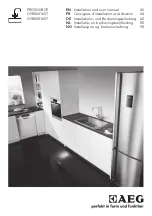
18
INS
TALLER
US
ER
MAINTEN
AN
CE TECHNI
CI
AN
1.18 FLUES, CHIMNEYS, CHIMNEY POTS
AND TERMINALS.
The flues, chimneys and chimney pots for the
evacuation of combustion products must be in
compliance with applicable standards. Chimneys
and roof-installed exhaust terminals must com-
ply with the outlet height and with the distance
from technical volumes set forth by the technical
standards in force.
Positioning the wall flue exhaust terminals.
The
wall flue exhaust terminals must:
- be installed on external perimeter walls of the
building;
- be positioned according to the minimum dis-
tances specified in current technical standards.
Combustion products exhaust of natural
draught or fan assisted appliances in open-top
closed environments.
In spaces closed on all
sides with open tops (ventilation pits, court-
yards etc.), direct combustion product exhaust
is allowed for natural draught or fan assisted gas
appliances with a heat input range from 4 to 35
kW, provided the conditions as per the current
technical standards are respected.
1.19 SYSTEM FILLING.
Once the boiler and the heat pump have been
connected, fill the system via the filling valve (Fig.
1-27 and 2-6). Filling is performed at low speed
to ensure release of air bubbles in the water via
the boiler, heat pump and heating system vents.
The boiler incorporates an automatic vent valve fit-
ted on the circulator pump and one on the system
vent tank.
Check if the cap is loose.
Open the radiator
vent valves.
Close radiator vent valves when only water
escapes from them.
Close the filling cock when the boiler pressure
gauge indicates approx. 1.2 bar.
N.B.:
during these operations activate the au-
tomatic vent functions featured on the boiler
(active upon initial ignition) and on the heat
pump (see relative instructions booklet).
Vent
the boiler circulation pump by loosening the front
cap and keeping the motor running.
Tighten the
cap after the operation.
1.20 CONDENSATE TRAP FILLING.
On first lighting of the boiler combustion prod-
ucts may come out the condensate drain; after a
few minutes’ operation check that this no longer
occurs. This means that the trap is filled with
condensate to the correct level preventing the
passage of combustion products.
1.21 GAS SYSTEM START-UP.
To start up the system, refer to the technical
standard in force.
In particular, for new gas systems:
- open windows and doors;
- avoid presence of sparks or open flames;
- bleed all air from the pipelines;
- check that the internal system is properly sealed
according to the specifications set forth by
technical regulations in force.
1.22 BOILER START UP (IGNITION).
To commission the boiler (the operations listed
below must only be performed by qualified per-
sonnel and in the presence of professionals only):
- check that the internal system is properly sealed
according to the specifications set forth by
technical regulations in force;
- make sure that the type of gas used corresponds
to boiler settings;
- Check that there are external factors that may
cause the formation of fuel pockets;
- switch the boiler on and check correct ignition;
- make sure that the gas flow rate and relevant
pressure values comply with those given in the
manual (Par. 3.20);
- ensure that the safety device intervenes in the
event of gas supply failure and check the relative
intervention time;
- check the intervention of the main switch
located upstream from the boiler and in the
boiler;
- check that the intake/exhaust concentric ter-
minal (if fitted) is not blocked.
The boiler must not be started up even if only
one of the checks should be negative.
















































